(Editor’s Introduction: Here Swami Amritageetananda (a senior disciple of Amma) shares the purpose and power of the Bhagavad Gita. This is one of the most sacred texts of Sanatana Dharma (Eternal Truth). Sanatana Dharma is the formal name for the broad and diverse Hindu religion and philosophy).
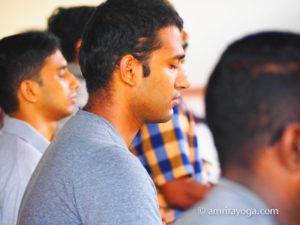 BHAGAVAD GITA – A SONG DIVINE
BHAGAVAD GITA – A SONG DIVINE
Once a year we offer special worship to the Divine Mother Bhagavad Gita by chanting Her eighteen chapters. To use the word “celebrate” is to dilute the sanctity of Bhagavad Gita, the Song Divine, that came out of Bhagavan Krishna’s Divine mouth. Just as Ganga Mata came out of Bhagavan Siva’s malted locks and purified the earth, so too Gita Mata came out of Bhagavan Krishna’s Divine mouth to purify human minds—to wash our sins and take us back to our Eternal Home—OM.
Ganga–Gita–Gayatri. These are three of the many Divine Mothers who purify us, their children. And among the three, our Acharyas [spiritual teachers] give the first place to Bhagavad Gita.
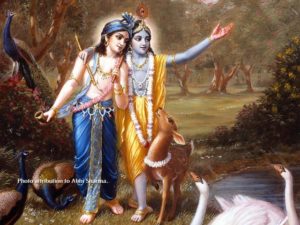 In order to get purified by Ganga, we have to travel a thousand miles north. Secondly, Gayatri mantra cannot be chanted out loud; therefore, it purifies only the person who chants it. But Bhagavad Gita finds Her way into every home and purifies not only those who chant it, but also those who are around the chanting person, listening to the chanting.
In order to get purified by Ganga, we have to travel a thousand miles north. Secondly, Gayatri mantra cannot be chanted out loud; therefore, it purifies only the person who chants it. But Bhagavad Gita finds Her way into every home and purifies not only those who chant it, but also those who are around the chanting person, listening to the chanting.
“Sarva Shastramayee Gita”
The Gita contains the essence of the Teachings of the entire Veda
Our Acharyas used to caution us, “Don’t say that I have gone through the Gita. Has the Gita gone through me?” and “Don’t say that I have learnt the Gita by heart—say that I have learnt the Gita by the heart.” Gita is a sacred song and a song can never be understood by the head—but only by the heart. This is why Bhagavan Krishna tells Arjun,
“Bhakthosi me Sabhaa chesi!”
O Arjuna, you are My devotee and friend—you have surrendered to Me. Therefore, I will teach you!
 Bhagavan says in the Gita,
Bhagavan says in the Gita,
“Shradhavaan labhathe Jnanam!”
One who has faith gains Knowledge.
Bhagavad Gita contains eighteen chapters. They teach that every one of us is Divine by nature. Our real nature is Pure Consciousness—Chaithanyam. A longtime back we were taught and believed that man is body plus soul. But the Gita reveals to us that man is soul in a body. The eighteen chapters explain the most sacred mantra Tat Tvam Asi—You Are That (Supreme Being).
The first six chapters explain the Tvam, which is the Individual person or the jivatma. The second six chapters explain the Tat or the Supreme Being. The last six chapters explain the Asi or how the individual person can merge into the Supreme Being. This is like a drop of water falling into the ocean and becoming one with the ocean.
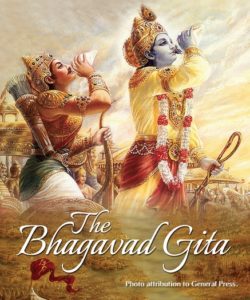 Our Guru Amma has demonstrated how the jivatma (individual person) is one with Paramatma (Supreme Being). On Bhava Darshan days, before the Devi Bhava Darshan starts, Amma sings bhajans like an ordinary human being craving for God: “Ethrayo Naalaayi Kaathirikyunnu Nhaan, Vyarthaamaayeedumo Jeevitham Ishwara. . .” (For how long have I been waiting for You O Lord; will my human life become purposeless?) After this Amma goes to the stage and within a few minutes reveals Her real nature as the Supreme Goddess. Amma teaches Tat Tvam Asi through Her actions.
Our Guru Amma has demonstrated how the jivatma (individual person) is one with Paramatma (Supreme Being). On Bhava Darshan days, before the Devi Bhava Darshan starts, Amma sings bhajans like an ordinary human being craving for God: “Ethrayo Naalaayi Kaathirikyunnu Nhaan, Vyarthaamaayeedumo Jeevitham Ishwara. . .” (For how long have I been waiting for You O Lord; will my human life become purposeless?) After this Amma goes to the stage and within a few minutes reveals Her real nature as the Supreme Goddess. Amma teaches Tat Tvam Asi through Her actions.
What is the content of the Bhagavad Gita teachings? The Gita begins with the word dharma or duty (“Dharmarshethre Kurukshethre. . .”) and ends with the word mama or mine (“Dhruva neethir mathir mama”). Therefore, the first and the last word form Dharma Mama or Mama Dharma — meaning my duty. This includes performance of one’s duties; remembering one’s role in family, society, and country; and lastly, one’s duty as a human being”.
Usually in situations and circumstances, we find that we have two problems:
- Ignorance of what should be done.
- Though we know what should be done, we generally do not have the strength to do what should be done.
 Bhagavad Gita gives us the clarity of vision (knowledge), purity of mind (devotion and surrender to God), and the strength to perform actions to the best of our ability.
Bhagavad Gita gives us the clarity of vision (knowledge), purity of mind (devotion and surrender to God), and the strength to perform actions to the best of our ability.
The main teaching or advice of the Bhagavad Gita can be summarized in two words: Bhagavan said,
“Maam anusmar Yudhya cha”
Remember Me and fight, O Arjuna
We should remember Bhagavan before action and while performing action with the attitude that we are only Bhagavan’s Instrument.
“Fight” here only means to perform your respective duties. Arjuna was a warrior and his duty was to fight.
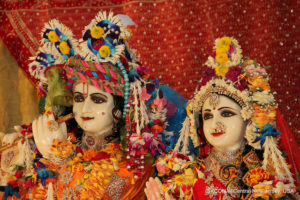 Kuru means action and kshethra means field. Thus, kurukshethra means field of action—our own field of work in daily life.
Kuru means action and kshethra means field. Thus, kurukshethra means field of action—our own field of work in daily life.
Arjuna’s chariot, in which Bhagavan Himself is the Charioteer, represents each one of us.
The human body is the chariot and Arjuna is the individual—each one of us. Our five senses—eyes, ears, nose, tongue, and touch— are the five horses. The different thoughts that come through the senses and become the mind are the reins of the horses. Bhagavan Krishna is the intellect. Thus, the five senses (horses) are controlled by the reins (thoughts in our mind) and the mind is controlled by the intellect (charioteer). Thus, the human body (chariot) is able to reach its destination. That destination is Divine Being, overcoming all obstacles.
What result do we get if we practice the Bhagavad Gita teachings?
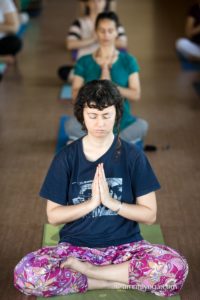 Bhagavan’s teachings begin with the word “ashochian”:
Bhagavan’s teachings begin with the word “ashochian”:
(Ashochian anvashochasthvam. . .)
Ashochian means “you need not grieve.” Bhagavan’s teachings conclude with the two words “maa Shuchaha,” meaning “do not grieve”. Therefore, Bhagavan’s teachings take us beyond all sorrows. This sacred teaching was given to the most qualified student, Arjuna, by the best teacher, Bhagavan Krishna. It was written in verses numbering seven hundred in eighteen chapters by Sage Vyasa, the best among Sages.
Bhagavad Gita is called “Advaitha Amritha Varshineem,” the rain of nectar called Advaita. Advaita is the highest experience of seeing all forms in this universe as manifestations of the Supreme Divine Being.
Our Amma is always in this highest state. Let us become Arjunas and drink this milk of the Bhagavad Gita. “Dugdham Gitamritham Mahath,” the glorious ever purifying milk—the teaching of the Bhagavad Gita that makes us Immortal.
Author, Swami Amritageetananda Puri
As always, thoughtful comments are invited and appreciated. Share your reflections with us! See below to leave a comment.

0 Comments